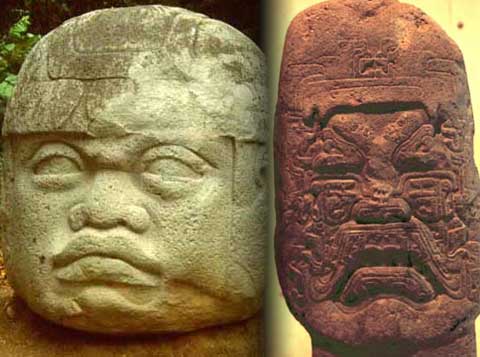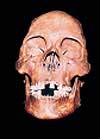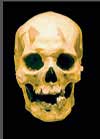2006 05 31
By George Erikson | AtlantisInAmerica.com

Olmec stone heads. Google image search.
In Atlantis In America: Navigators of the Ancient World Ivar Zapp and I proposed that when the identities of the first Americans were finally known that they would likely turn out to be South Pacific Islanders. The idea that open-sea navigators would be the first Americans was the result of our belief that the great stone spheres of Costa Rica were sculpted by the earliest peoples in the Americas and that they resembled structures used as sighting stones throughout the Pacific. The Te Atibu ni Borau (“The Stones for Voyaging”) of the Gilbert Islands were both similar in construction and were laid out in configurations very like the spheres of Costa Rica.
Ivar and I were equally sure that dates preceding Clovis or any possible land migration were already being discovered or were on the very near horizon. We documented Anna Roosevelt’s finds of sophisticated rock art at Monte Alegra in Brazil carbon14 dated to a minimum of 11,200 YBP, and Tom Dillehay’s find that Monte Verde in southern Chile at 12,800 BP predated any Clovis site. Dillehay was vilified by conventional archaeologists. When James Dixon, Curator and Professor of Archaeology at the University of Alaska, rose to Dillehay’s defense, he was fired. It was not until the Smithsonian sent three distinguished archaeologists to Monte Verde to review Dillehay’s work that he was exonerated. Dr. Brian Fagan, Professor of Anthropology at the University of California, Santa Barbara, wrote in an Archaeology Magazine review that Dillehay’s work was “exhaustive, exemplary… and unassailable.” Since Fagan had authored The Great Journey, the story of the settling of America through Beringia migration, I thought his assessment showed unusual fair-mindedness. As I’d known him for many years, I sent Fagan a note expressing this. He called back to say that he still believed in “Clovis first” and Beringia migration and that anyone who proposed an earlier people in the Americas was guilty of “pseudo-science”. He went on to say that I had become a “new-ager” and that my ideas were “very wrong and on very dangerous ground.”
However, it is Dr Fagan and his indignant fellow archaeologists who have been proven wrong. It now appears that the earliest settlers of America may have come from the Pacific, Australia, southern Asia, or even Europe.
The Error
Since most American Indians resemble the people of Mongolia, China and Siberia, conventional wisdom has held that the first Americans originated from northern Asia. PaleoIndians have been thought to be descended from prehistoric hunters who, following large game, walked from northeast Asia across a land bridge, formed at the end of the Ice Age, to Alaska some 12,000 years ago, and then migrated across North and South America.
In the 1930s, archeologists found stone spear points among the bones of mammoths near Clovis, New Mexico. Radio carbon dating in the 1950s showed that the oldest site was 11,400 years old. The sites were assumed, for years, to be the first evidence of human occupation in the Americas. Since a break in the huge ice sheets that could have enabled migration had occurred only a few hundred years before the date of the Clovis site, it was assumed that the migration was very swift.
From the 1930s to just a few years ago, the question of who colonized the Americas, and when, was no longer debated in academic circles. Despite the improbability of migration over a land bridge between Siberia and Alaska, then over a two mile thick ices sheet for 4,000 miles, or thorough an equally perilous corridor filled with raging ice sheet melt waters, Beringia migration was taken as fact.
"(A fact) that had been repeated so many times in textbooks and lectures it became part of the common lore," said Dennis Stanford, curator of archeology at the Smithsonian Institution. "People forgot it was only an unproven hypothesis." It was only an assumption. Now a growing body of evidence has prompted even the most unyielding archaeologists and other scientists to accept challenges to that assumption
The Beringia Migration theory was the property of the Clovis First! people who dominated American Archaeology from the late 1920s (when the first bi-facial points were found at Clovis New Mexico)until the mid-nineties. Mammoth skeletons and bison skeletons have been found in association with these points in many places subsequently, and it was assumed that when human skeletons were to be found that they would be short and broad faced like the north-eastern Asians that they descended from. However, no human skeletons with Amerindian features were found that dated back more 7,800 YBP. When, within the last decade, human skulls were carbon dated to an earlier time, they were found to be doliocephallic (long and narrow- faced like Europeans). Also, it was expected that an earlier version of the Clovis point would be found in Siberia confiming migration across the dried-up Bering Sea (Beringia). But no Clovis-like point has ever been found in Siberia nor in any part of Asia. Dennis Stanford believes that the Clovis point had its bi-facial equivalent among the Cro-Magnon peoples of western Europe and that they migrated by boat to the American east coast from 16,000 to 30,000 years ago.
Luzia- the Doliocephallic skull
Recent discoveries challenge the Clovis story. In Brazil, archaeologists found some of the oldest human remains in the Americas, among them a skeleton—named Luzia—that is more than 11,000 years old.
Luzia did not look like American Indians. Instead, her facial features matched most closely with the native Aborigines in Australia. . A reconstruction of the cranium of "Luzia" (11,300BP) found by Walter Neves in south-central Brazil, reveals craniofacial patterns of a Polynesian. These people date back to about 60,000 years and were themselves descended from the first humans who probably originated in Africa.
Neves and other the researchers In Brazil believe Luzia was part of a people, referred to as "Paleoamericans," who migrated into the Americas— most probably by boat—long before the Mongoloid people. These Paleoamericans may later have been wiped out by or interbred with Mongoloids invading from the north.
The Pericue
Recent research, including the Baja California study, indicates that the initial settlement of the continent was instead driven by Southeast Asians who occupied Australia 60,000 years ago and then expanded into the Americas about 13,500 years ago, prior to Mongoloid people arriving from northeast Asia. A study of skulls excavated from the tip of Baja California in Mexico also suggests that the first Americans may not have been the ancestors of today's Amerindians, but another people who came from Southeast Asia and the southern Pacific area. This tribe, which lived on the Baja California peninsula, was called the Pericue. Their population had survived into historic times, but they appear to have died out in the 18th Century because of disease.
Spanish missionaries reported that they were of a different racial type and had different customs to other Native Americans. The skulls from Baja California, which may date back only a few hundred years, have slender-looking faces that are different from the broad-cheeked craniums of modern Amerindians, the descendants of the Mongoloid people.
However, some scientists think that the older group of Americans may simply have evolved the features typical of present-day natives of the continent.
"Our results change the traditional idea that all modern Amerindians present morphological affinities with East Asians as a result of a single migration," said Rolando González-José of the University of Barcelona, Spain, who led the study. "The settlement of the New World is better explained by considering a continuous influx of people from Asia."
The late skulls found in Baja California are similar to Luzia and the Paleoamerican skulls found in South America. Their craniums are characterized by long and narrow vaults, with faces short and low in relation to the neurocranium.
"Skeletal studies demonstrate that skeletal remains do not fit the Mongoloid set of traits that is determinant of the modern Amerindian morphology," said González-José. "Our results demonstrate that not only are some early remains not Mongoloid, but also some modern groups, like those of Baja California."
To some the study suggests that Baja California was one of many isolated pockets throughout the Americas where Paleoamerican traits survived. The Paleoamericans might have split at one point, with one group going down to Baja California. This group may not have come in contact with Paleoindians for millennia.
Some experts, however, find it difficult to believe that such a population could have evolved in isolation.
"I don't doubt there's skeletal diversity and that it's probably coming out of old world Asia," said Tom Dillehay, chief archeologist at the Monte Verde site commented on the study. "But I am very skeptical of a population, particularly close to a coastline, that could have been isolated for more than 10,000 years."
Dr Sylvia Gonzalez, of Liverpool’s John Moores University also doubts the doliocephallic heads could have evolved due to isolation.
“The Pericu were able seafarers and came from the same lineage as modern Australian Aborigines. They could have come out of Australia, hopped along Japan and the Aleutian Islands, and followed the coast to America,” Gonzalez says. “Baja California was like a cul-de-sac, where they got trapped.”
Penon Woman
Dr Sylvia Gonzalez is best known for her discovery, in a museum, of the skull of a woman who come to become known as Peñon Woman III. The first time she saw it was in 2,000 in a museum, although the skull had been found in Mexico City in 1959. Because it was long and narrow, not round and broad cheeked like the usual skulls of prehistoric Native Americans,Silvia Gonzalez knew there was something special about the skull.
“It looked so incredibly different,” Gonzalez says. “Physically, it was very pleasing to the eye.”
 
Courtesy of Instituto Nacional de Antropologia e Historia (INAH), Mexico
The artificially red Pericu skull (left) is decidedly longer and narrower than the broad, round Mongoloid skull (right) typical of prehistoric Native Americans. |
Gonzalez, a geoarchaeologist, and her colleagues at Liverpool John Moores University in England radiocarbon-dated the skull and found its beauty was more than bone deep. Surprising many, the analysis showed Peñon Woman III is 12,755 years old, older than any known ancestor of modern Native Americans. Based on skull comparisons, Gonzalez announced in September, she believes Peñon Woman III was an ancestor of the Pericu,
Dr Silvia Gonzalez conducted a study of ancient bones found in Mexico and found that they have very different characteristics to Native Americans. Some of the ancient skulls she has looked at are more than 12,000 years old.
These skulls have long and narrow heads that are very different from the short, broad skulls of today's Native Americans.
"We think there were several migration waves into the Americas at different times by different human groups."
She said there was very strong evidence that the first migration came from Australia via Japan and Polynesia and down the Pacific coast of America.
Dr Gonzalez said the research would be controversial. "[Native Americans] cannot claim to have been the first people there," Dr Gonzalez said.
She also hinted that DNA recovered from Penon Woman would corroborate measurements of the skulls. "We have extracted her DNA. It is going to be a bomb," Dr Gonzalez commented.
If proved correct, the findings might have implications for US legislation that covers the return of Native American remains and artifacts to present-day tribes.
Recently, a coalition of native tribes lost their claim to the remains of Kennewick Man, a 9,000-year-old skeleton found in Washington State. The case was won by a group of scientists who wanted access to the remains for study. Like Penon Woman, Kennewick Man is doliocephallic. George Gill, a forensic anthropologist at the University of Wyoming and one of the plaintiffs in the Kennewick Man case, said evidence indicated that seafaring people from southeast Asia or Polynesia could have reached the Americas by traveling along the Pacific Rim, landing somewhere in what is now South America. Gill also said an ancient European people could also have reached the northeast corner of North America.
Europeans and Africans BC (Before Columbus)?
In Atlantis In America: Navigators of the Ancient World Zapp and I documented the presence of Mediterranean and African faces sculpted into stone throughout MesoAmerica. The 3,000 year old Olmec carved faces at La Venta (Mexico) are unmistakably African, with broad lips, broad noses, braided hair and kinky beards. The 2,000 year old carved faces at Maya sites like Chichen Itza (Yucatan) and El Ceibal (Guatemala) are unmistakably Mediterranean as they display long narrow faces, long beards and bushy mustaches – features very unlike the Maya. Stone stelae at Copan (Honduras) display Chinese features, while the 15 foot tall statues at Tula (Valley of Mexico) display the features of Polynesians. It now appears that all these diverse people were coming to the heart of the Americas from 1,500 to at least 15,000 years ago. The complex origins of the first Americans has also been confirmed by DNA studies that have revealed the presence of haplogroup X among Algonkian-speaking tribes such as the Ojibway. Today, haplogroup X is found in between two and four per cent of European populations, and in the Middle East, but it has never been found in northeast Asian peoples.
The question is no longer, “Did navigators come to the New World before Columbus and Lief Erikson?” The question is when did they stop coming, and why did they lose all memory of man’s navigational past? In Europe the answer may be tied to the onset of the Dark and Middle Ages. We are becoming inured to catastrophic events of late. But what event caused the Dark ages to begin and the history of navigation and other knowledge to become lost? The answer to that question still eludes us.
www.AtlantisInAmerica.com
Related: DNA evidence for Atlantis
Ancient Receivers the Costa Rican Spheres?
1421 - The year China discovered the world
The Bearded Gods of All the Major Religions
White and bearded God
